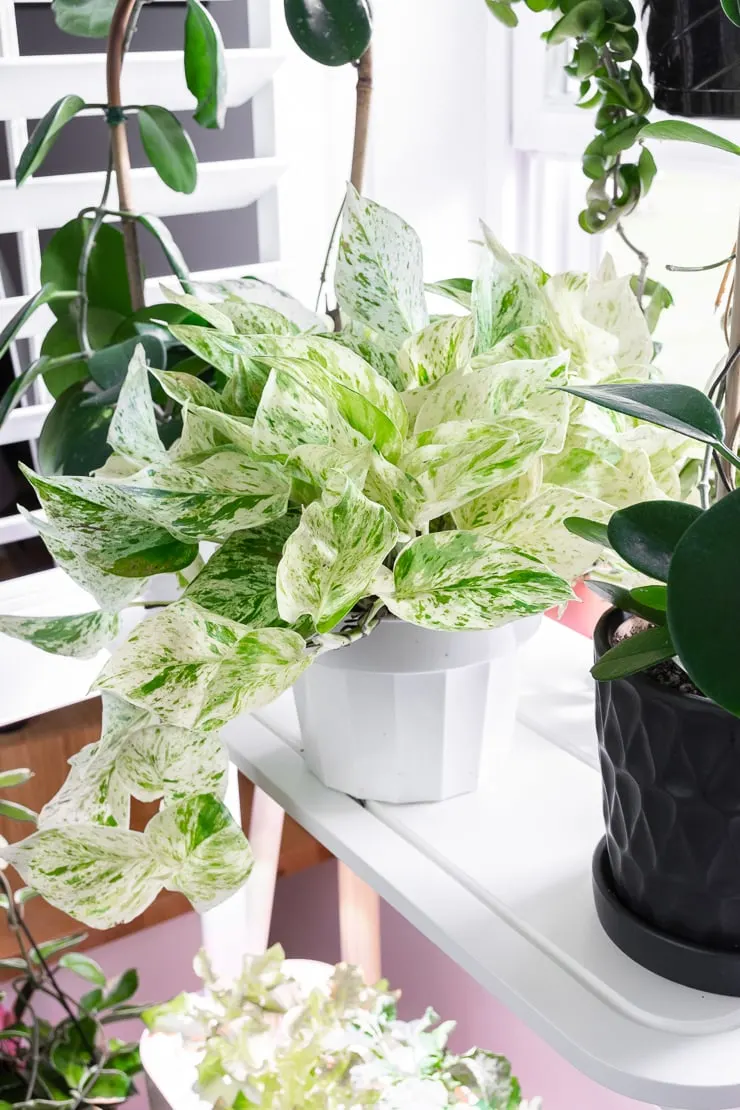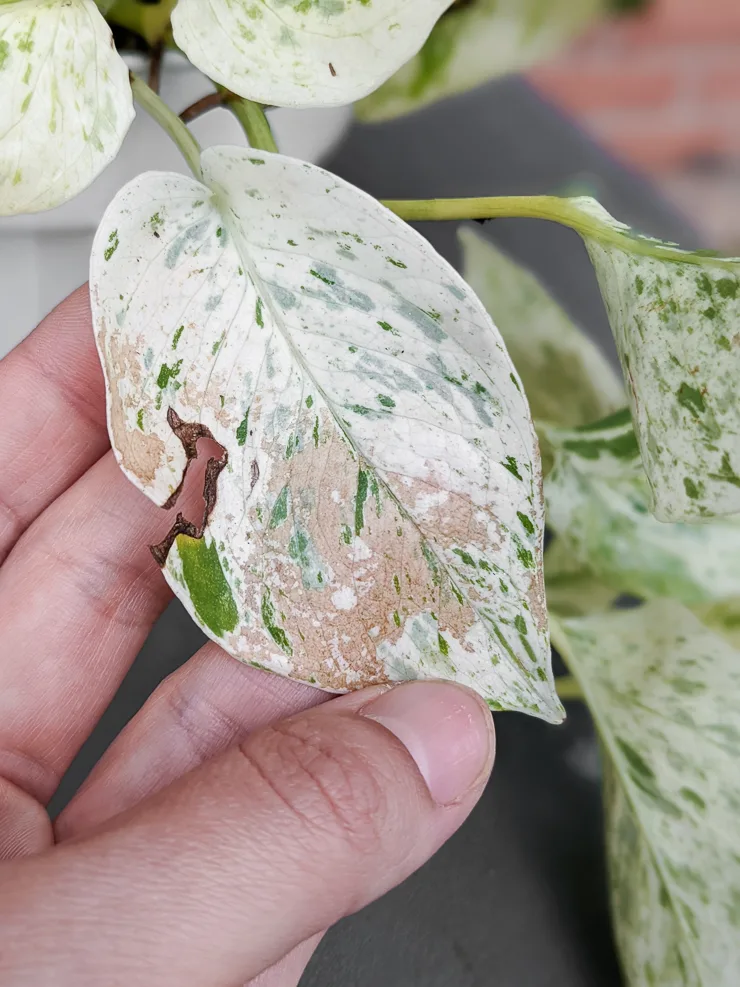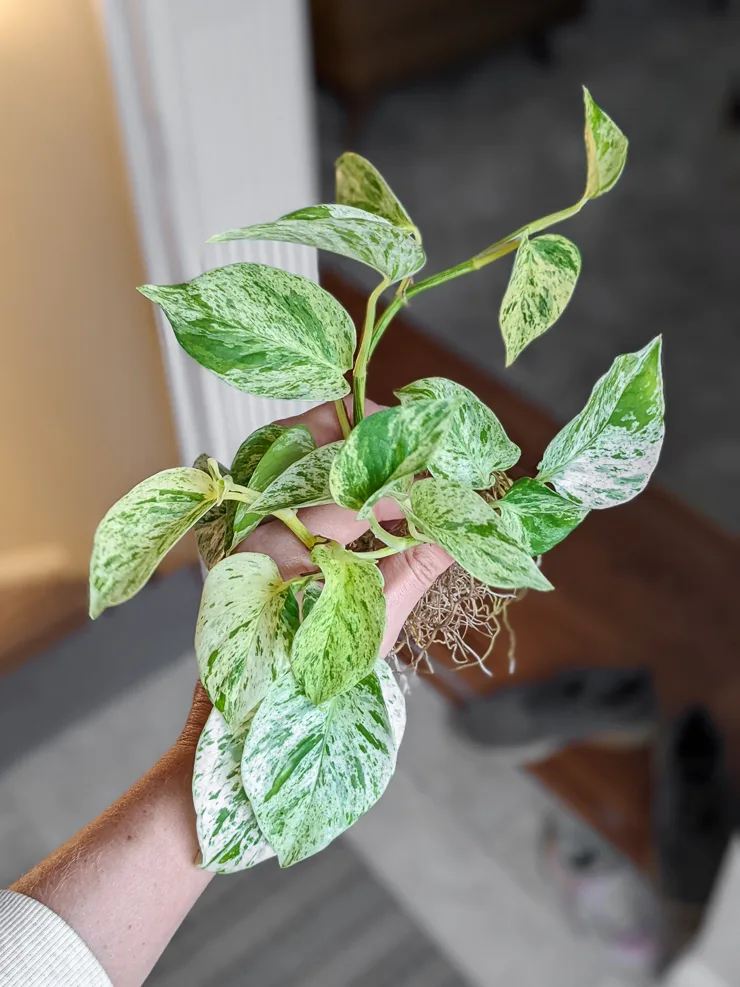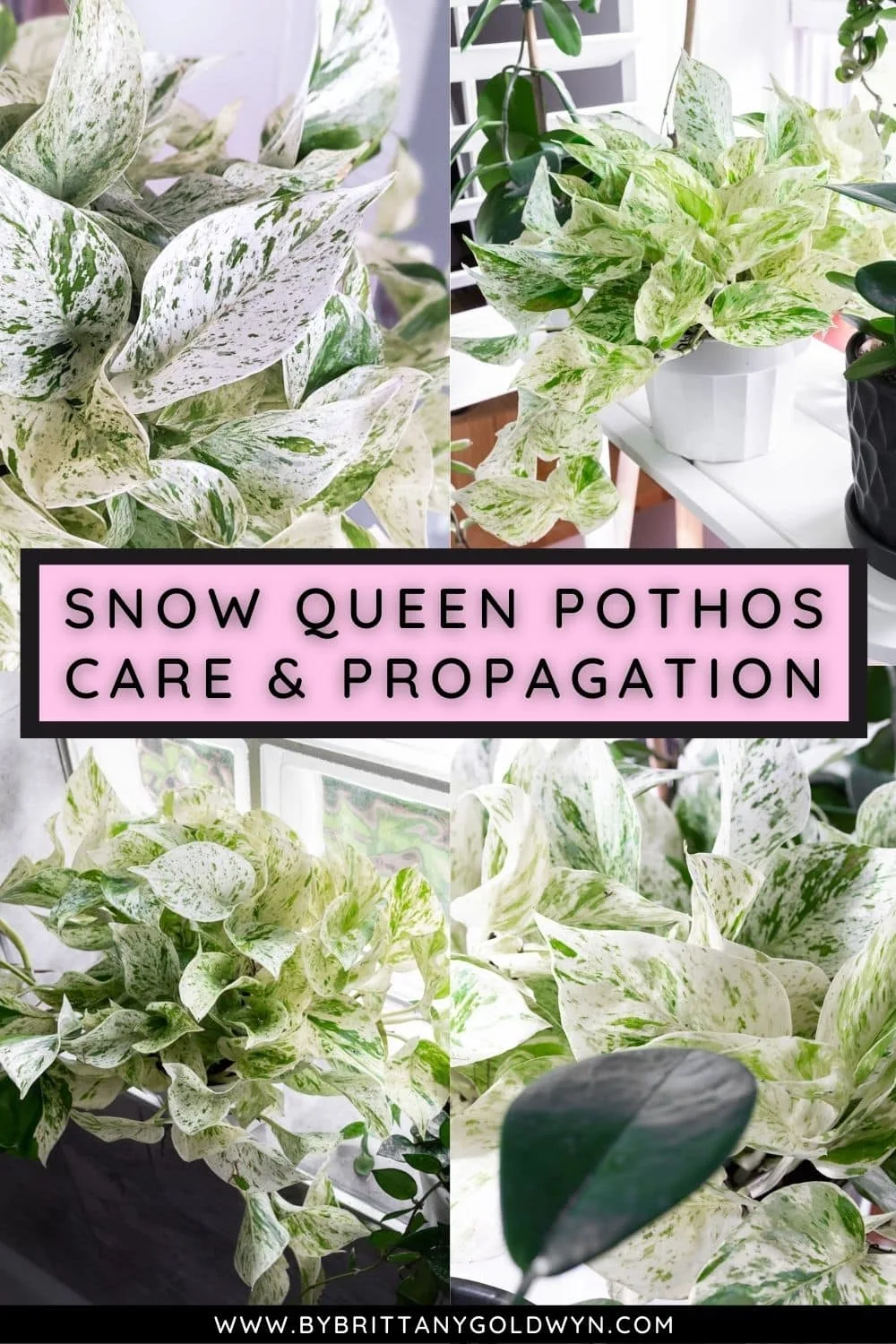Snow queen pothos is a gorgeous variegated variety of epipremnum aureum to add to your houseplant collection. Learn all about its quirks and how to keep it happy with my snow queen pothos care guide!
Let’s talk about snow queen pothos care
It has been a while since I’ve done a good ol’ pothos care post, and that’s probably because I’ve written about mostly all pothos varieties I’ve been able to get my hands on! Today’s post is about snow queen pothos, a variety of epipremnum aureum (see my general epipremnum aureum care post for more).
Here are a few other varieties of epipremnum aureum pothos I’ve written about:
You may be wondering what a snow queen pothos plant is. Can you find it locally? Is it rare? Is it the same thing as a marble queen pothos, just highly variegated? Can marble queen pothos turn into snow queen? I’m going to ramble on about all of these things.

Epipremnum aureum “snow queen” origins
Epipremnum aureum as a general genus and species is native to Southeast Asia. I couldn’t find the exact origin of the snow queen variety, but my guess is that it’s somewhere around there. And it was probably a result of either a hybridized plant or a rando mutation that someone ran with.
Snow queen pothos has the same familiar heart-shaped leaves that other epipremnum aureum pothos plants have. It vines and climbs, so it looks lovely in a hanging basket or climbing a moss pole.
The thing that makes snow queen pothos unique and a bit more interesting than some other pothos plants, though, is its gorgeous variegation. The leaves are generally very light—nearly white—with green variegation and speckles on them.
You might think, “Brittany, you’re talking about a marble queen pothos.” And I could be, because the marble queen pothos plant is very similar to the snow queen pothos plant. And it’s easy to confuse the two. But I own both, so let’s have a nosy at them!

Is there a difference between snow queen and marble queen pothos?
Yes, indeed there is a difference between snow queen and marble queen pothos! Sometimes it is difficult to determine which plant you have without seeing the two plants next to one another, though.
The easiest way to determine the difference between the two plants is to look at the variegation and coloring on the leaves. The marble queen pothos generally has green and pale yellow variegation on the leaves.
This variegation has a marbled, striped, or speckled look. If a marble queen pothos is in lower light, the leaves will likely have more green and less variegation (normal for variegated plants).
A snow queen is essentially a lighter colored plant. The variegation on snow queen leaves tend to be more white (less yellow, though they can be cream) with spotted and flecked green variegation. As with the marble queen pothos, snow queen needs a lot of light to maintain its variegation.

Can marble queen pothos turn into snow queen?
No, because they are different plants, snow queen pothos cannot turn into marble queen pothos. However! If it’s that stunning light-colored variegation you’re after, you can enhance the variegation on your marble queen pothos by giving it plenty of bright indirect light.
I have seen some highly variegated marble queen pothos plants that are real head turners. They are so light and bright that they almost look like snow queen plants. But the light-colored variegation still tends to be cream-colored or yellow-hued, while snow queen is more of a true white.

How much light does a snow queen pothos need to maintain variegation?
Snow queen pothos plants in general do not need a ton of light. They can do well in medium light levels. But, unlike their slightly hardier relatives the golden pothos and the jade green pothos, I wouldn’t put them in lower light levels.
That’s because the variegation in the leaves is a result of having less chlorophyll. That’s right—the white parts of the snow queen’s leaves do not contain chlorophyll, and chlorophyll is the magic sauce in the leaves that help the plant absorb energy from light sources to undergo photosynthesis.
And that means that the leaves have less surface area to take in light and grow, meaning that you definitely want to maximize the light the plant gets. Bright indirect light is best, and this plant will be perfectly fine with just a few hours of bright indirect light.
I have mine in an area that gets bright indirect light for most of the day—a south-facing window that is largely unobstructed. Ensuring your snow queen gets plenty of light is also a great way to encourage a highly variegated plant. Less light will dull your variegation and slow growth.
While this plant enjoys plenty of bright indirect light, avoid too much direct sunlight. It can burn the leaves. Some direct morning sun is probably fine since that sun is much weaker. however, keep an eye on the plant for signs of distress if you have concerns about the plant’s placement.


Water & soil needs
The water and soil needs for a snow queen pothos plant are much like any regular pothos plant. I plant all of my pothos plants in a well-draining houseplant soil mix. These plants are not terribly picky as long as their soil is well-draining.
Occasionally I like to throw in an extra handful of perlite or coco coir when repotting my pothos plants. Perlite helps facilitate drainage, while coco coir is a great alternative to peat moss that retains moisture without keeping the soil too wet.
And keeping the soil too wet is a sure-fire way to kill a pothos plant. They are susceptible to root rot and do not like their roots sitting in water. I water my pothos plants only after the soil has almost entirely dried out.
You can safely water your pothos plant after the top several inches of soil dry out, but I like to err on the side of potentially underwatering my plants. That’s because they tend to withstand neglect well and bounce back quickly if I push them too far without water, while they are not as forgiving of overwatering.
If your snow queen pothos gets a lot of light, it will probably dry out faster and need more water. That’s why it’s always best to check your soil for clues instead of keeping a strict schedule. (Though you’ll definitely get into a rhythm once you settle your plant into its new home.)
When I water my pothos plants, I also like to water them deeply in the sink, shower, or outside in the spring and summer. This means that I thoroughly soak the soil, letting all of the excess water drain out of the drainage holes.
While I am doing this, I also rinse off all of the foliage as best I can. Including the undersides of the leaves. This helps keep the leaves clean and dust-free. It’s also a great best practice for pest prevention.


Temperature & humidity
The snow queen pothos plant’s temperature and humidity needs also mirror those of other epipremnum aureum family members, with one caveat. Snow queen will benefit from some extra humidity, which will help prevent the super white parts of the leaves from browning.
Extra humidity along with great light and warm temperatures work together to keep those leaves white. If you notice browning, crispy spots on the leaves—especially the white parts—consider your humidity levels.
That said, this plant generally does well in all household humidity levels. It is a patient pothos, after all. Just monitor it for any issues and adjust as necessary.
As for temperature levels, it also does well in a variety of normal household temperatures. Between 60 and 85 degrees Fahrenheit is best. As a tropical plant, though, it definitely enjoys warmer temperatures. This plant is not cold or frost hardy and will die if temperatures are consistently below 50 degrees.
I like to take some of my pothos plants outdoors for the spring and summer so they can soak up the warm, humid Maryland summers. But they need to come back inside in the fall—at least where I live.


Snow queen pothos growth rate & repotting needs
As a variegated plant, snow queen pothos is generally a slower grower—at least when compared to some of its relatives, which grow like absolute weeds. (And in some cases grow so prolifically that they have become invasive, like some areas in Florida.)
Plenty of bright indirect light will help speed up this plant’s growth. If you have it in medium or lower light levels, its growth rate will definitely slow down.
Boosting humidity levels will also help the snow queen’s growth, especially as it relates to leaf size. I am always astounded by how large my pothos plant leaves get when I have them outside in our super humid summers! It always makes me a little sad when I have to bring my plants inside for their long, sad winter.
I recommend repotting your snow queen pothos every few years and sizing up only an inch or two when you do. I wait until the roots begin growing out of the pot’s bottom to repot, too. Otherwise, it still has a bit of room to grow, and there’s no need to disturb it.
When you do repot your snow queen, make sure to use fresh soil to replenish its nutrients.

Want more pothos? Check out my Baltic Blue Pothos Care & Propagation guide, my Epipremnum Pinnatum Variegata Albo Propagation & Care, and my Cebu Blue Pothos Care & Propagation!
Fertilizer—is it necessary?
And speak of nutrients, pothos plants generally do not need to be fertilized as long as you use a high-quality soil that has nutrients in it. However, nutrients to deplete over time, so if you haven’t repotted your pothos plant in a while, fertilizer can be helpful.
I recommend using something like organic worm castings that you can work into the top layer of soil. When you water the plant, the nutrients will disperse throughout the plant’s root system.
I’ve also started using Liqui-Dirt roughly every three or four times I water my houseplants, too. I like using this highly concentrated fertilizer because I can just pour a bit in my watering can.
It isn’t a chemical fertilizer either, so you don’t have to worry about over-fertilizing your plants and burning them. It’s good stuff, and my plants seem to be really happy with it added to their care routine.

How to propagate a snow queen pothos
Snow queen pothos plants are quite easy to propagate from cuttings. Simply take a cutting of your plant that has roughly 2–3 leaves and 1–2 nodes.
You can take a cutting that has a little bump on the stem where an aerial root would eventually grow, or you can take a cutting and remove the lower-most set of leaves to expose growth points. Then it’s time to prepare your medium.
Water propagation
Pothos cuttings are so easy to propagate that you can just pop the cutting into water and wait. Refresh the water every week or so, and make sure the growth points are always submerged in water.
Once the cutting has roots that are several inches long, you can transplant the cutting to soil. Keep the soil moist as the cutting’s water roots acclimate to soil and transition. Don’t worry if your cutting wilts a bit—it will rebound.
After the cutting takes root, you can begin treating your new snow queen pothos plant as normal.


Moss propagation
I also like using moss as a propagation medium for pothos cuttings. The roots generally grow stronger, and the plant doesn’t suffer as much transplant shock when you transfer it to soil.
To propagate a pothos cutting using moss, simply wet sphagnum moss and squeeze out all of the excess water. The moss should remain moist. Mix with some perlite and put in a little cup. Add the cutting and keep a clear baggie over the cutting—or add it to a DIY plastic propagation box.
Ensure the moss stays moist and the environment remains humid to encourage root growth. Once you have roots, you can transfer the cutting to soil just as you’d do with a water propagation. (For more on this, check out my Sphagnum Moss Propagation 101 post.)

Pest issues to be aware of
Snow queen pothos plants are not terribly vulnerable to pests. Just the normal houseplant pests you might encounter, and they’ll likely either enter your home on another plant and spread to the snow queen or come as a terrible bonus gift on your new snow queen.
Mealybugs are some of the most common pothos pests. They look like white cotton masses on your plant, most notably where the leaves meet the stems. See my post for more on identifying mealybugs and getting rid of them.
Fungus gnats are another common household pest that are more annoying than they are harmful. They can also signal an overwatering issue in your care routine because they lay eggs in moist soil. To get rid of them, make sure you are letting the top few inches of soil dry out!
I have a post all about how to get rid of gnats in houseplants, and it also includes what causes them. Check that out for a detailed post on the topic.
Toxicity
Pothos plants in general are considered mildly toxic when ingested, and this includes snow queen pothos. Keep this plant away from both pet and human nibblers.
Pin my snow queen pothos care guide!




